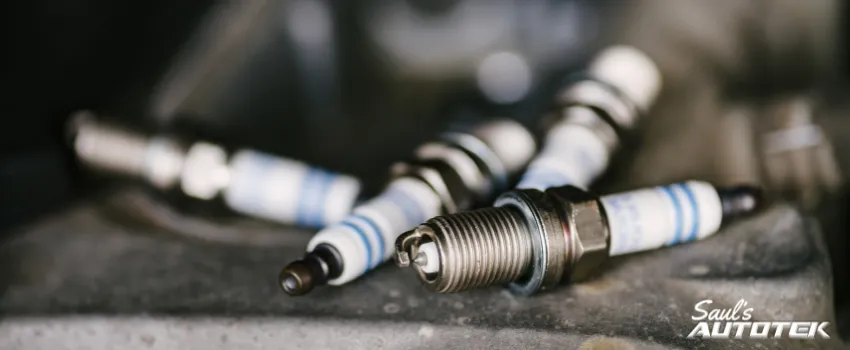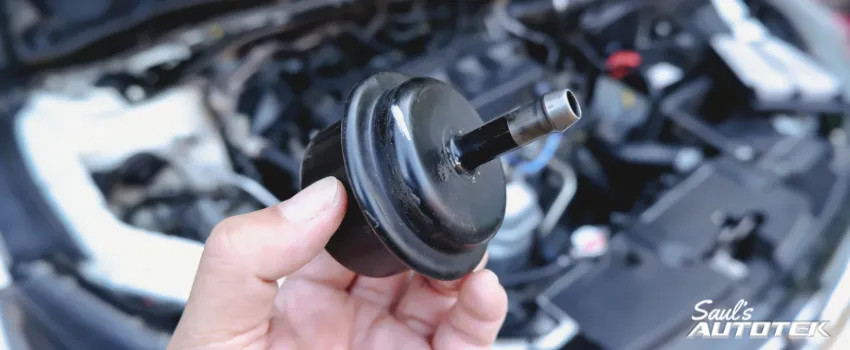I’m Saul Reisman here at Saul’s AUTOTEK, and today we’re going to show you one of the vehicles we work on and how we try and take things one step further to make sure you get the perfect repair the right time, the first time, every time.
In the case of this Lincoln MKZ, also known as a Ford Taurus; to many of us that been doing this for a while, the vehicle came to us with a misfire. Pretty basic concern, the owner said, “Hey, it’s got a PO302, it’s missing on cylinder two, can you tell me what’s going on? It runs really rough.” Now, the original diagnostic that he’d received from the local repair shop told him that he had a misfire and you should replace the coil for the ignition on that cylinder, you should be good to go. Well, we took a quick look at the vehicle and we found a few things out of the ordinary.
Now we’ve got the plenum top plastic cover off so we can show you the new coils that we’ve gone and installed in this engine and we’ve replaced the front three ignition coils and the back three that reside back here underneath the intake manifold. Unfortunately, we can’t get a good view of those guys. That’ll take us a couple of hours to disassemble. The reason I’m talking about this vehicle is, this isn’t a complicated repair.
30 years ago you had to take a vehicle in to get its spark plugs changed every five or 10000 miles. As time and technology change, we had better ways to distribute the spark to the cylinder in a more direct manner, and that meant instead of having a distributor or an ignition coil set spark from a coil to a distributor that they rotated making contacts, creating point of resistance and friction and heat and then set that spark through wires that went to the spark plugs and then sent that spark down to the engine. We now have vehicles that run with a single ignition coil, essentially directly attached to the spark plug itself, firing directly into the engine. As a result, there really shouldn’t be anything in the middle that can fail.
There’s a great technological improvement and way to make sure that we have good consistency of service on motor vehicles. However, it leads to some problems. Now most motor vehicles that you’ll see us talk about, we referenced it being a 12-volt system, almost anything in the automotive industry that’s not a heavy-duty diesel application will operate off 12 volts. However, most of these sensors and circuitry on engines themselves, operate off of a five-volt circuit and we typically call this a driver circuit. Now, just like your computer can have a driver program so that it can communicate with its printer or scanner appropriately, and if that doesn’t work right, the signals get crossed and your homework assignment doesn’t come off the printer. Similar things can happen here, but the repercussions can be substantially, substantially more detrimental. In the case of this vehicle, the ECU or engine control unit, generates 12 volts and that’s what it’s working off of from the alternator and the vehicle for it to properly do its job, operate as a computer and send voltage and signals to other pieces and parts of the car.
Now that means that ECU might be sending 12 volts on a driver circuit to the fuel pump. However, it’s typically sending five volts on a driver circuit to any of the sensors on the engine itself. Whether that means a camshaft or crankshaft position sensor, a fuel pressure sensor or something of that nature, it’s typically looking at a lower voltage response. Just like your house might run off 110, 120 volts, but your doorbell probably runs off of 12 and has a step-down transducer built-in somewhere. The downside of this type of design and having a direct line of connection between the ignition coil and the spark plug is things can go both directions. Streets run two ways and it’s not always fun when that happens. Just like the benefits of indoor plumbing are fantastic, but when they don’t work right, you might end up with a very bad smell inside your home.
In the case of this vehicle, the ECU is sending a five-volt circuit to the ignition coil telling it to fire the coil and it’s sending 12 volts to actually supply the coil with voltage, so the coil is operating off that 12 volt and uses a five-volt signal to get the trigger to send a pulse to each spark plug. It’s not sending out a constant arc, but sending individual pulses for a very, very short duration, oftentimes just thousands of a second in order to send that lightning bolt of electricity to the spark plug, get that fire to ignite and light off that fuel-air mixture inside the cylinder. Now, had we replaced just a single-coil and sent this owner on its way, it probably would have run right for a few minutes, but we probably wouldn’t have had a very happy owner because that’s not actually what was the problem with this vehicle.
Now, even though the codes shown indicated a miss on two and the codes indicated that the ignition coil on cylinder two was in fact defective, the reason that it was defective was not clear.
Had we just replaced that coil, we’d be trading just a symptom and not the cause of the problem. There are three words that we’re going to listen to every time you bring your vehicle in: complaint, cause, cure. Those are the only things that matter to us, here at Saul’s AUTOTEK. And in this case, specifically, that ignition coil which generates 50000 volts from the 12 volts going to it and the five-volt driver circuit applied to it, was actually shorting and sending that signal directly backward and into the five-volt driver circuit for the engine control unit or ECU. As a result, the ECU, the computer, the brain of the vehicle, was damaged and the driver circuit on it was destroyed.
Had we simply replaced that one ignition coil, thrown it back in and sent it on its way, that new ignition coil would’ve been producing additional voltage compared to the shorted one and could it potentially caused further damage to the vehicle. Maybe it would have destroyed the ECU completely and stopped the vehicle from running or a short circuit could’ve caught the vehicle on fire. Fortunately, because we have ASE master certified technicians here at Saul’s AUTOTEK, we were able to accurately diagnose from the get-go that the engine control unit is actually what had failed on the vehicle and that’s what led to the driver circuit failing and led to that ignition coil failing. As a result, we replaced the ECU, the wiring between it and that ignition coil and that ignition coil and spark plug, and the problem is solved. So if you’ve got a concern about your vehicle, whether it’s something as basic as a spark, but you want to make sure you get the best quality of service, no matter what, that’s what AUTOTEK is for.
We’re going to be the best service that you can get for the best dollar that we can provide so that you know you’re going to leave with the best result every time. You don’t want to go to a mechanic and come back because it didn’t work 20 minutes later, and we want to make sure that you leave with a vehicle that is the absolute perfection it was when it left the dealership when it leaves you. That’s part of why we do an extensive test drive on the vehicle afterward to make sure that this guy’s going to go 10 miles down the road and not have any issues.
We don’t want to see it come back in the next day, and nor do you.
We want you on the road, we want you safe, we want you reliable.
So even though the corner mechanic might be the cheapest and fastest solution some of the time, the best solution is typically to go to the specialist. Just like you might go to urgent care or the emergency room for something quick and painful, or you’re going to go see your regular care primary physician for the things that matter most, that keep you alive and keep you healthy in the long run, we want to be your primary care mechanic and we want to keep you on the road. We’ll see you soon.
Schedule Your FREE diagnostic Subaru Outback Auto Repair Upkeep and Repair Appointment
Check out Our Reviews On Yelp! And Leave A Great One For Us!
Join Our Conversation on Facebook
Explore Our Exceptional Denver Auto Repair Services
- Brake Repair Service
- Suspension Repair
- Steering Repair
- Engine Repair
- Automotive Air Conditioning and Heating Repair





